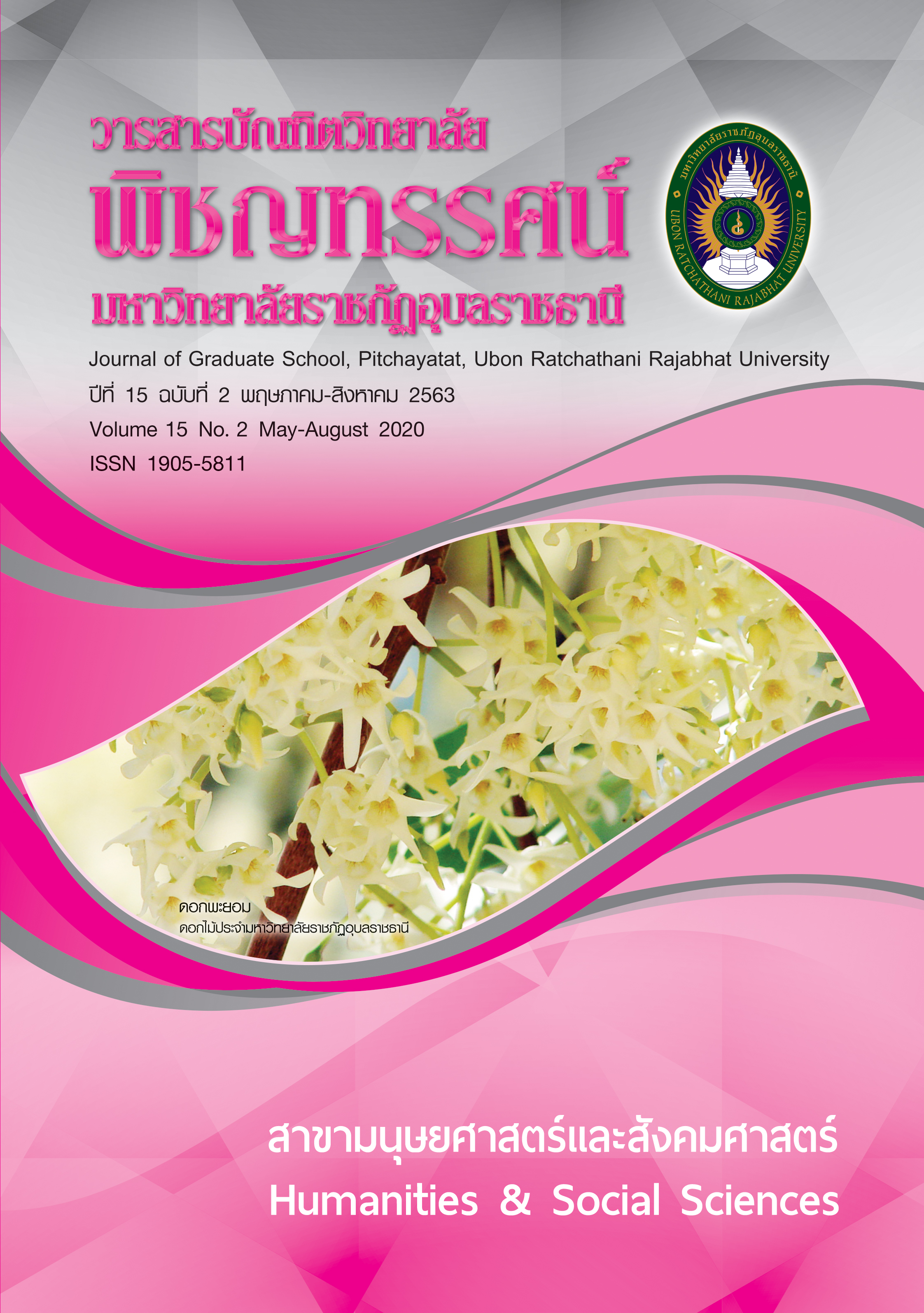การพัฒนาชุดกิจกรรมการเรียนรู้โดยใช้กระบวนการเรียนรู้ตามแนวคิด ICANDO เรื่อง การประดิษฐ์เศษวัสดุในท้องถิ่นกลุ่มสาระการเรียนรู้การงานอาชีพและเทคโนโลยี สำหรับชั้นประถมศึกษาปีที่ 3
คำสำคัญ:
กระบวนการเรียนรู้ ICANDO, กลุ่มสาระการเรียนรู้การงานอาชีพและเทคโนโลยีบทคัดย่อ
การวิจัยนี้มีวัตถุประสงค์เพื่อ 1) พัฒนาชุดกิจกรรมการเรียนรู้โดยใช้กระบวนการเรียนรู้ ICANDO กลุ่มสาระการเรียนรู้การงานอาชีพและเทคโนโลยี สำหรับนักเรียนชั้นประถมศึกษาปีที่ 3 ให้มีประสิทธิภาพตามเกณฑ์ 80/80 2) เพื่อเปรียบเทียบผลสัมฤทธิ์ทางการเรียน เรื่อง การประดิษฐ์เศษวัสดุในท้องถิ่น กลุ่มสาระการเรียนรู้การงานอาชีพและเทคโนโลยี สำหรับนักเรียนชั้นประถมศึกษาปีที่ 3 ที่เรียนด้วยชุดกิจกรรมการเรียนรู้โดยใช้กระบวนการเรียนรู้ ICANDO ก่อนเรียนและหลังเรียน ตัวอย่างที่ใช้เป็นนักเรียนชั้นประถมศึกษาปีที่ 3 ภาคเรียนที่ 2 ปีการศึกษา 2558 โรงเรียนบ้านโนนแคน สำนักงานเขตพื้นที่การศึกษาประถมศึกษาอุบลราชธานี เขต 5 จำนวน 30 คน ได้มาโดยวิธีการสุ่มแบบกลุ่ม เครื่องมือที่ใช้ คือ ชุดกิจกรรมการเรียนรู้โดยใช้กระบวนการเรียนรู้ ICANDO เรื่อง การประดิษฐ์เศษวัสดุในท้องถิ่น และแบบทดสอบวัดผลสัมฤทธิ์ทางการเรียน สถิติที่ใช้ได้แก่ ร้อยละ ค่าเฉลี่ย ส่วนเบี่ยงเบนมาตรฐาน และการทดสอบที
ผลการวิจัยพบว่า
- ชุดกิจกรรมการเรียนรู้โดยใช้กระบวนการเรียนรู้ ICANDO เรื่อง การประดิษฐ์เศษวัสดุในท้องถิ่น กลุ่มสาระการเรียนรู้การงานอาชีพและเทคโนโลยี สำหรับนักเรียนชั้นประถมศึกษาปีที่ 3 มีประสิทธิภาพเท่ากับ 87.81/84.67
- นักเรียนที่เรียนด้วยชุดกิจกรรมการเรียนรู้โดยใช้กระบวนการเรียนรู้ ICANDO กลุ่มสาระการเรียนรู้การงานอาชีพและเทคโนโลยี มีคะแนนเฉลี่ยผลสัมฤทธิ์ทางการเรียนหลังเรียนสูงกว่าก่อนเรียนอย่างมีนัยสำคัญทางสถิติ
คำสำคัญ: กระบวนการเรียนรู้ ICANDO กลุ่มสาระการเรียนรู้การงานอาชีพและเทคโนโลยี
เอกสารอ้างอิง
ดุษฎี โยเหลา และคณะ. การศึกษาการจัดการเรียนรู้แบบ PBL ที่ได้จากโครงการสร้างชุดความรู้ เพื่อสร้างเสริมทักษะแห่งศตวรรษที่ 21 ของเด็กและเยาวชน: จากประสบการณ์ความสำเร็จ ของโรงเรียนไทย. กรุงเทพฯ: วิสุทธิ์, 2557.
เพชรรัตน์ นามมั่น. สอนงานอาชีพอย่างไรให้นักเรียนเกิดความคิดสร้างสรรค์ บทความเผยแพร่ทางวารสารสิ่งพิมพ์. (ออนไลน์) 2559 (อ้างเมื่อ 25 มิถุนายน 2562). https://www.kanpeo.go.th/wp-content/uploads/2018/06/
รัชนี ดวงสินธิ์. “การพัฒนาชุดการสอน เรื่อง งานประดิษฐ์จากผ้า กลุ่มสาระการเรียนรู้การงานอาชีพและเทคโนโลยี ชั้นมัธยมศึกษาปีที่ 3,” บัณฑิตวิทยาลัย พิชญทรรศน์. 5 (มกราคม-มิถุนายน 2553): 84-90.
วงศ์รวี มีศิริ. “กลุ่มสาระการเรียนรู้การงานอาชีพและเทคโนโลยี ชั้นประถมศึกษาปีที่ 6 โดยใช้กระบวนการออกแบบย้อนกลับ,” ศึกษาศาสตร์. 27, 1 (มกราคม-เมษายน 2559): 101-112.
วารุณี แก่นทน. “การเปรียบเทียบผลสัมฤทธิ์ทางการเรียน กลุ่มสาระการเรียนรู้การงานอาชีพและเทคโนโลยี สำหรับนักเรียนชั้นประถมศึกษาปีที่ 3 เรื่องการสืบค้นข้อมูลจากอินเทอร์เน็ตที่จัดการเรียนรู้ด้วยบทเรียนคอมพิวเตอร์ช่วยสอนกับการจัดการเรียนรู้ด้วยวิธีปกติ,” บัณฑิตวิทยาลัย มหาวิทยาลัยรามคำแหง. 5 (ฉบับพิเศษ ข) (เมษายน-มิถุนายน 2558): 291-299.
ศึกษาธิการ, กระทรวง. ตัวชี้วัดและสาระการเรียนรู้แกนกลาง กลุ่มสาระการเรียนรู้การงานอาชีพและเทคโนโลยี. สำนักคณะกรรมการศึกษาขั้นพื้นฐานกระทรวงศึกษาธิการ, กรุงเทพฯ: โรงพิมพ์ชุมนุมสหกรณ์การเกษตรแห่งประเทศไทย จำกัด, 2560.
ศุภเนตร นอบน้อม. “การพัฒนาทักษะกระบวนการปฏิบัติงานของนักเรียนชั้นมัธยมศึกษาปีที่ 3 ที่เรียนโดยใช้สื่อประสมประกอบการจัดการเรียนรู้เรื่อง การปลูกผักสวนครัว,” วารสารวิจัยและพัฒนามหาวิทยาลัยราชภัฏบุรีรัมย์. 11, 1 (มกราคม-มิถุนายน 2559): 51-61.
Meeks, S. E. “Learning package versus conventional method of instruction,” Dissertation Abstracts International. 32, 9 (June 1972): 4995-A.
ดาวน์โหลด
เผยแพร่แล้ว
รูปแบบการอ้างอิง
ฉบับ
ประเภทบทความ
สัญญาอนุญาต
บทความทุกเรื่องได้รับการตรวจความถูกต้องทางวิชาการโดยผู้ทรงคุณวุฒิภายนอกอย่างน้อย 2 คน ความคิดเห็นในวารสารบัณฑิตวิทยาลัย พิชญทรรศน์ มหาวิทยาลัยราชภัฏอุบลราชธานี เป็นความคิดเห็นของผู้เขียนมิใช่ความคิดเห็นของผู้จัดทำ จึงมิใช่ ความรับผิดชอบของบัณฑิตวิทยาลัย มหาวิทยาลัยราชภัฏอุบลราชธานี และบทความในวารสารบัณฑิตวิทยาลัย พิชญทรรศน์ มหาวิทยาลัยราชภัฏอุบลราชธานี สงวนสิทธิ์ตามกฎหมายไทย การจะนำไปเผยแพร่ต้องได้รับอนุญาตเป็นลายลักษณ์อักษรจากกองบรรณาธิการ






